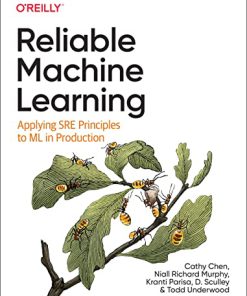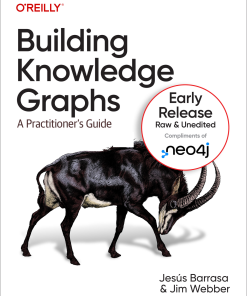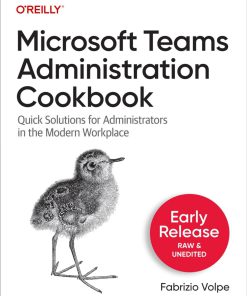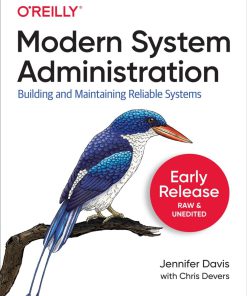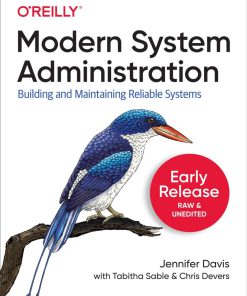Modern System Administration Building and Maintaining Reliable Systems 1st Edition by Jennifer Davis, Tabitha Sable, Chris Devers ISBN 9781492055204 1492055204
$50.00 Original price was: $50.00.$25.00Current price is: $25.00.
Modern System Administration Building and Maintaining Reliable Systems 1st Edition by Jennifer Davis, Tabitha Sable, Chris Devers – Ebook PDF Instant Download/Delivery: 9781492055204 ,1492055204
Full download Modern System Administration Building and Maintaining Reliable Systems 1st Edition after payment
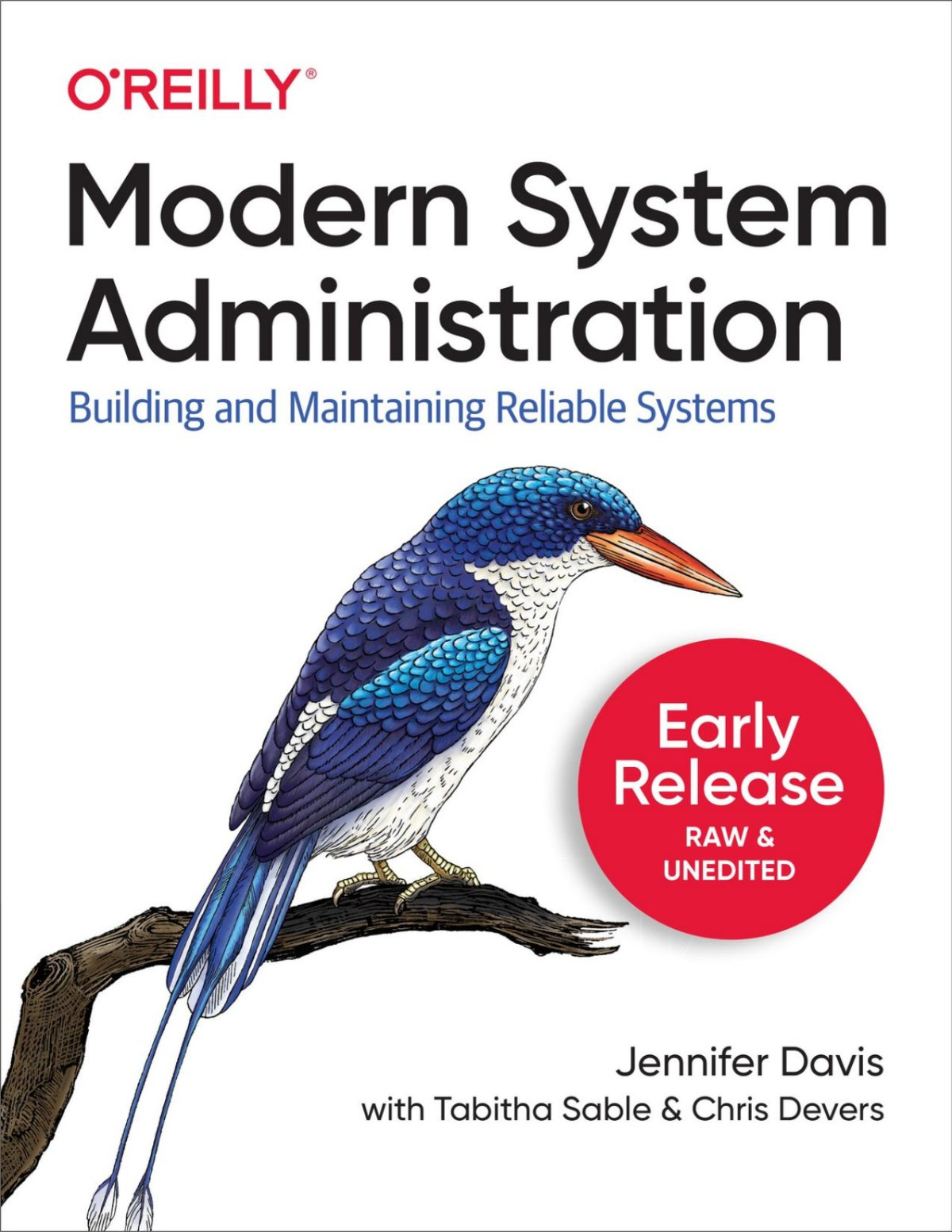
Product details:
ISBN 10: 1492055204
ISBN 13: 9781492055204
Author: Jennifer Davis, Tabitha Sable, Chris Devers
Modern System Administration Building and Maintaining Reliable Systems 1st Edition Table of contents:
I. Reasoning About Systems
1. Patterns and Interconnections
-
How to Connect Things
-
How Things Communicate
-
Application Layer
-
Transport Layer
-
Network Layer
-
Data Link Layer
-
Physical Layer
-
Wrapping Up
2. Computing Environments
-
Common Workloads
-
Choosing the Location of Your Workloads
-
On-Prem
-
Cloud Computing
-
Compute Options
-
Serverless
-
Containers
-
Virtual Machines
-
Guidelines for Choosing Compute
-
Wrapping Up
3. Storage
-
Why Care About Storage?
-
Key Characteristics
-
Storage Categories
-
Block Storage
-
File Storage
-
Object Storage
-
Database Storage
-
Considerations for Your Storage Strategy
-
Anticipate Your Capacity and Latency Requirements
-
Retain Your Data as Long as Is Reasonably Necessary
-
Respect the Privacy Concerns of Your Users
-
Defend Your Data
-
Be Prepared to Handle Disaster Recovery Situations
-
Wrapping Up
4. Network
-
Caring About Networks
-
Key Characteristics of Networks
-
Build a Network
-
Virtualization
-
Software-Defined Networks
-
Content Distribution Networks
-
Guidelines to Your Network Strategy
-
Wrapping Up
II. Practices
5. Sysadmin Toolkit
-
What Is Your Digital Toolkit?
-
The Components of Your Toolkit
-
Choosing an Editor
-
Choosing Programming Languages
-
Frameworks and Libraries
-
Other Helpful Utilities
-
Wrapping Up
6. Version Control
-
What Is Version Control?
-
Benefits of Version Control
-
Organizing Infra Projects
-
Wrapping Up
7. Testing
-
You’re Already Testing
-
Common Types of Testing
-
Linting
-
Unit Tests
-
Integration Tests
-
End-to-End Tests
-
Explicit Testing Strategy
-
Improving Your Tests; Learning from Failure
-
Next Steps
-
Wrapping Up
8. Infrastructure Security
-
What Is Infrastructure Security?
-
Share Security Responsibilities
-
Borrow the Attacker Lens
-
Design for Security Operability
-
Categorize Discovered Issues
-
Wrapping Up
9. Documentation
-
Know Your Audience
-
Dimensions of Documentation
-
Organization Practices
-
Organizing a Topic
-
Organizing a Site
-
Recommendations for Quality Documentation
-
Wrapping Up
10. Presentations
-
Know Your Audience
-
Choose Your Channel
-
Choose Your Story Type
-
Storytelling in Practice
-
Case #1: Charts Are Worth a Thousand Words
-
Case #2: Telling the Same Story with a Different Audience
-
The Key Takeaways
-
Know Your Visuals
-
Visual Cues
-
Chart Types
-
Recommended Visualization Practices
-
Wrapping Up
III. Assembling the System
11. Scripting Infrastructure
-
Why Script Your Infrastructure?
-
Three Lenses to Model Your Infrastructure
-
Code to Build Machine Images
-
Code to Provision Infrastructure
-
Code to Configure Infrastructure
-
Getting Started
-
Wrapping Up
12. Managing Your Infrastructure
-
Infrastructure as Code
-
Treating Your Infrastructure as Data
-
Getting Started with Infrastructure Management
-
Linting
-
Writing Unit Tests
-
Writing Integration Tests
-
Writing End-to-End Tests
-
Wrapping Up
13. Securing Your Infrastructure
-
Assessing Attack Vectors
-
Manage Identity and Access
-
How Should You Control Access to Your System?
-
Who Should Have Access to Your System?
-
Manage Secrets
-
Password Managers and Secret Management Software
-
Defending Secrets and Monitoring Usage
-
Securing Your Computing Environment
-
Securing Your Network
-
Security Recommendations for Your Infrastructure Management
-
Wrapping Up
IV. Monitoring the System
14. Monitoring Theory
-
Why Monitor?
-
How Do Monitoring and Observability Differ?
-
Monitoring Building Blocks
-
Events
-
Monitors
-
Data: Metrics, Logs, and Tracing
-
First-Level Monitoring
-
Event Detection
-
Data Collection
-
Data Reduction
-
Data Analysis
-
Data Presentation
-
Second-Level Monitoring
-
Wrapping Up
15. Compute and Software Monitoring in Practice
-
Identify Your Desired Outputs
-
What Should You Monitor?
-
Do What You Can Now
-
Monitors That Matter
-
Plan for a Monitoring Project
-
What Alerts Should You Set?
-
Examine Monitoring Platforms
-
Choose a Monitoring Tool or Platform
-
Wrapping Up
16. Managing Monitoring Data
-
What Is Monitoring Data?
-
Metrics
-
Logs
-
Structured Logs
-
Tracing
-
Distributed Tracing
-
Choose Your Data Types
-
Retain Log Data
-
Analyze Log Data
-
Monitoring Data at Scale
-
Wrapping Up
17. Monitor Your Work
-
Why Should You Monitor Your Work?
-
Manage Your Work with Kanban
-
Choose a Platform
-
Find the Interesting Information
-
Wrapping Up
V. Scaling the System
18. Capacity Management
-
What Is Capacity?
-
The Capacity Management Model
-
Resource Procurement
-
Justification
-
Management
-
Monitoring
-
The Framework for Capacity Planning
-
Do You Need Capacity Planning with Cloud Computing?
-
Wrapping Up
19. Developing On-Call Resilience
-
What Is On-Call?
-
Humane On-Call Processes
-
Check Your On-Call Policies
-
Preparing for On-Call
-
One Week Out
-
The Night Before
-
Your On-Call Rotation
-
On-Call Handoff
-
The Day After On-Call
-
Monitor the On-Call Experience
-
Wrapping Up
20. Managing Incidents
-
What Is an Incident?
-
What Is Incident Management?
-
Planning and Preparing for Incidents
-
Set Up and Document Communication Channels
-
Train for Effective Communication
-
Create Templates
-
Maintain Documentation
-
Document the Risks
-
Practice Failure
-
Understand Your Tools
-
Clearly Define Roles and Responsibilities
-
Understand Severity Levels and Escalation Protocols
-
Responding to Incidents
-
Learning from the Incident
-
How Deep Should You Dig?
-
Aiding Discovery
-
Documenting Incidents Effectively
-
Distributing the Information
-
Next Steps
-
Wrapping Up
21. Leading Sustainable Teams
-
Collective Leadership
-
Adopt a Whole-Team Approach
-
Build Resilient On-Call Teams
-
Update On-Call Processes
-
Monitor the Team’s Work
-
Why Monitor the Team?
-
What Should You Monitor?
-
Measure Impact on the Team
-
Support Team Infrastructure with Documentation
-
Budget a Learning Culture
-
Adapt to Challenges
-
Wrapping Up
People also search for Modern System Administration Building and Maintaining Reliable Systems 1st Edition:
what is system administration
what is system administration and maintenance
modern administrative state
modern systems of government
modern systems advanced
Tags: Jennifer Davis, Tabitha Sable, Chris Devers, Modern System Administration
You may also like…
Computers - Operating Systems
AWS System Administration, 2nd Edition (Second Early Release) Mike Ryan And Federico Lucifredi
Computers - Organization and Data Processing
Computers - Applications & Software
Microsoft Teams Administration Cookbook (First Early Release) Fabrizio Volpe
Computers - UNIX & Linux
Practical Linux System Administration Fourth editon by Ken Hess
Computers - Operating Systems
Uncategorized
Uncategorized
Computers - Operating Systems




